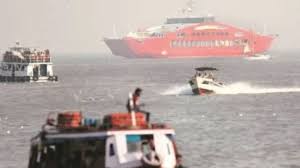What are RoRo ferries, which Goa hopes will replace traditional boats?

Goa, India’s smallest state by area, is known for its sun-kissed beaches, vibrant culture, and scenic rivers. For decades, its residents have relied on traditional ferries to cross these rivers, especially in areas lacking bridge infrastructure. However, with growing traffic congestion and the need for efficient connectivity, the state is turning its focus to a more modern solution: RoRo ferries. But what exactly are these ferries, and how do they differ from traditional boats? Let’s dive into the details.
What Are RoRo Ferries?
RoRo stands for Roll-on/Roll-off. These are specially designed ferries that allow vehicles — including cars, bikes, buses, and even trucks — to drive directly onto the ferry at the starting point and off at the destination. The entire process is streamlined using built-in ramps or platforms, eliminating the need for cranes or manual vehicle loading.
Unlike traditional boats, which are often restricted to carrying passengers and two-wheelers, RoRo ferries are capable of transporting both people and their vehicles together. This feature alone makes them an attractive proposition for areas with high vehicle traffic and limited bridge access.
Key Characteristics of RoRo Ferries:
- Vehicle-Friendly: Capable of transporting two-wheelers, four-wheelers, and even heavy goods vehicles.
- Integrated Boarding: Vehicles roll on and roll off through ramps, reducing loading/unloading time.
- Safe and Efficient: Built with modern safety standards and designed to handle heavy loads and multiple vehicle types.
- Passenger Comfort: Equipped with seating areas, safety gear, and in some cases, air-conditioned cabins.
Why Is Goa Shifting to RoRo Ferries?
Goa has a rich network of rivers — the Mandovi, Zuari, and Chapora being among the most prominent. While bridges connect some of the major towns, there are still many areas where ferry transport remains the only viable option for daily commuting. Traditional boats are effective for basic passenger movement but are falling short in meeting the needs of modern transportation.
Here are some key reasons why the Goa government is promoting RoRo ferries:
1. Decongesting Roads and Bridges
With Goa’s growing population and booming tourism industry, roads and bridges — especially in Panaji, Margao, and Vasco — face increasing congestion. RoRo ferries can act as an alternative route, allowing people to avoid long traffic jams during peak hours.
2. Improving Connectivity
Many rural and semi-urban areas in Goa are still cut off from major towns, especially during monsoons when water levels rise. RoRo ferries can bridge the gap — literally — by providing consistent transport regardless of weather conditions.
3. Reducing Travel Time
In many parts of Goa, crossing a river could take 30–40 minutes by road due to detours. A RoRo service could reduce that to under 10 minutes, saving fuel and time for daily commuters.
4. Boosting Eco-Friendly Transport
Water transport, especially with modern RoRo vessels running on hybrid or electric engines, offers a greener alternative to road vehicles. Fewer vehicles on the road mean reduced emissions and a smaller carbon footprint — aligning with Goa’s environmental goals.
5. Supporting Tourism Growth
Tourism is the backbone of Goa’s economy. RoRo ferries can provide tourists with a unique travel experience, allowing them to explore riverine areas with ease. Imagine driving your rental scooter onto a ferry and sailing across the Mandovi to reach Old Goa or Divar Island — it adds to the charm and convenience of exploring the state.
Government Initiatives and Plans
The Government of Goa, through its partnership with the Inland Waterways Authority of India (IWAI) and private players, has already begun taking steps to operationalize RoRo services. In 2023, the state inaugurated one such service between Betim and Panaji, which showed promising results.
Several more routes are being evaluated, including:
- Cortalim – Agassaim (across the Zuari River)
- Old Goa – Divar Island
- Chorao – Ribandar
These projects involve constructing modern jetties, developing parking facilities, and ensuring proper safety protocols. The state is also exploring public-private partnerships (PPP) to manage and operate these ferries efficiently.
Challenges and Considerations
While the introduction of RoRo ferries seems promising, the transition comes with its own set of challenges:
- Infrastructure Development: New ramps and docking stations need to be built, requiring land acquisition and environmental clearances.
- Maintenance Costs: RoRo ferries are more complex than traditional boats and require higher maintenance.
- Public Adaptation: Locals, especially in rural areas, may need time to trust and adapt to this new mode of transport.
- Monsoon Preparedness: Goa’s heavy rainfall can disrupt services unless vessels are built to withstand rough river conditions.
What It Means for the Average Goan
For the average commuter or tourist, RoRo ferries could be a game-changer. No more waiting in traffic snarls on narrow bridges or taking long detours to reach your destination. Whether you’re a daily office-goer from Ponda or a tourist heading to Divar Island, RoRo services can save time, reduce costs, and offer a smoother travel experience.
Moreover, it signals a modernization of Goa’s public transport system — one that values efficiency, sustainability, and innovation.
Final Thoughts
As Goa balances its cultural heritage with rapid urbanization, RoRo ferries represent a bold step toward the future. By replacing traditional boats with these multi-utility vessels, the state is not just easing congestion but also investing in smarter, greener mobility. If implemented effectively, RoRo transport can become a model for other coastal states in India, helping them unlock the potential of inland waterways in a sustainable way.






